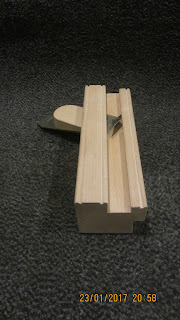I am back at work and that also means that I manage to find some time to sit in front of a computer and do a bit of blogging.
This past home period saw a bit of woodworking, as I managed to complete the second traveling bookcase for my daughter. I also made 5 window frames for the small barn. I never got around to taking any pictures of all that, so you will just have to take my word for it..
I think it is fair to say that the single most important thing that happened this home period was getting a new dog.
We drove down to near Hannover in Germany and picked up the most adorable little Newfoundland puppy.
She has grown considerably since then, but she is just as sweet and cuddly.
It is probably impossible to not compare a new puppy with the old dog, and often the new dog will fall short in comparison due to the strong memories of the old dog and it setting te standards for good behavior.
In one respect the new puppy (Bertha) actually comes out in front of our old dog Fnug:
Fnug never really liked to stay in the workshop.
She would enter occasionally - take a look around and then leave again.
Bertha on the other hand seems to think that the shop is a great place to stay, and that is something that warms my heart.
She likes to sleep while I work at the bench, and when she is awake she helps by rearranging small pieces of scrap wood.
There are a few drawbacks too though. The major one being that she has the idea the the broom is meant as a toy, and subsequently attacks it as soon as I start sweeping the floor.
Sweeping is not very efficient with a 35 Lb puppy attached to the head end of a broom playing tug of war while you try to clean the floor.
But given her sweet nature I can easily live with that and I'll just sweep the floor while she is not in the shop.
Besides getting a new dog, we also had a really nice Christmas and New Years Eve.
This Sunday a friend called asking if we wanted to join her on a ride in the forest. Laura was at home and really wanted to participate. Mette suggested that I took her her horse, and then she would just walk besides us all. Since the ground was frozen, we were only going to let the horses walk, so Mette wouldn't have any problems in keeping up with us.
It was such a nice trip, and I actually think that I ought to do a bit more riding. What a fine way to experience nature.
Four years ago I participated in the SSBO (shop stool build off), and it was such a great thing to participate in.
Chris had manged to attract some incredibly fine sponsor prizes, and the entire build off couldn't have been organized any better.
I highly recommend you to register and participate in the build. If it is anything like the last event, there will be loads of prizes, for numerous categories, Since the design limits for the build are very wide, it is especially interesting to see what other people come up with. .
The skill level of the participants last time ranged as did the design. I think that the most interesting stool built last time was the innovative works of
Alex Leslie. He rightfully won a prize for that entry.
Bertha resting in the shop.
Shavings from the planer stick incredibly well to a soft coat of fur.
Gustav and Bertha right after getting her home.
Jonas/ Bent, Lene/Marco, Laura/Fairy







































